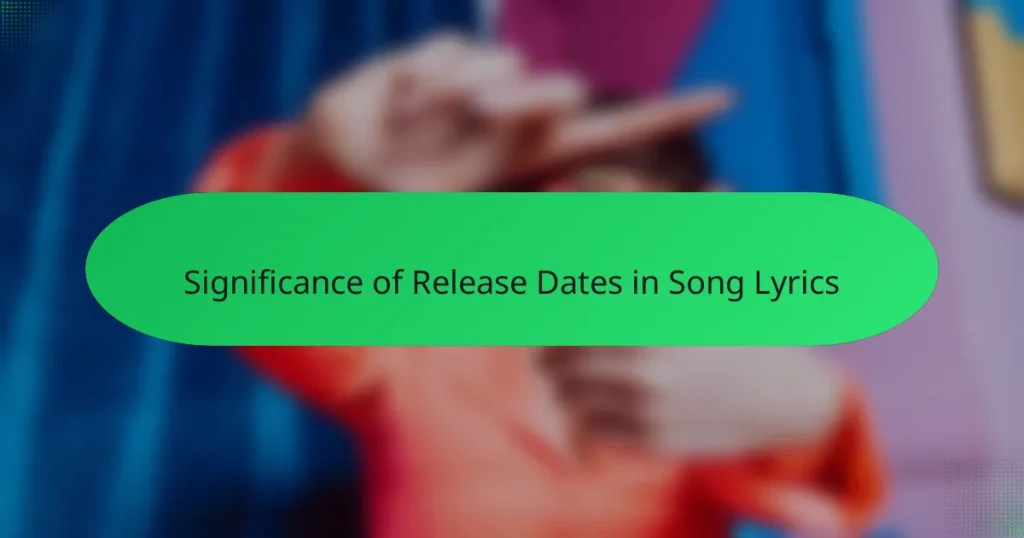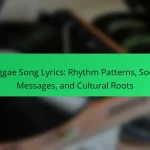Release dates in song lyrics serve as crucial markers that provide context and relevance to a song’s themes, reflecting the time period of its creation and influencing cultural and emotional resonance. These dates can enhance listeners’ understanding of an artist’s intent and impact a song’s popularity and chart performance, particularly when aligned with significant events or holidays. Fans often associate songs with personal memories tied to their release dates, leading to deeper emotional connections and insights into the artist’s storytelling. However, challenges such as timing relevance, market competition, and audience engagement must be navigated to ensure a song’s success upon release. Overall, the significance of release dates is integral to understanding the narrative and emotional landscape of music.
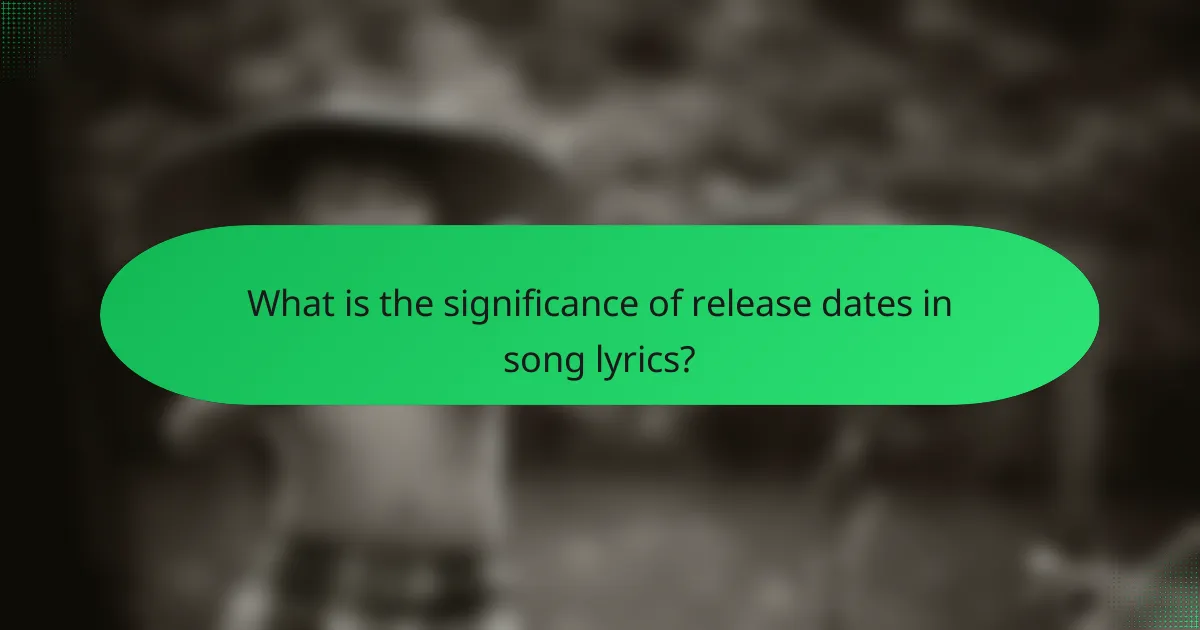
What is the significance of release dates in song lyrics?
Release dates in song lyrics are significant as they provide context and relevance to the song’s themes. They can indicate the time period in which the song was created, influencing its cultural and emotional resonance. For example, a song released during a political movement may reflect the sentiments of that era. Additionally, release dates can affect a song’s popularity and chart performance. Songs released at strategic times, such as holidays or events, may gain more traction. The historical context tied to a release date can also enhance listeners’ understanding of the artist’s intent. Overall, release dates contribute to the narrative and impact of a song within its cultural landscape.
How do release dates influence the interpretation of song lyrics?
Release dates significantly influence the interpretation of song lyrics. The context surrounding a song’s release often shapes its meaning. Historical events, cultural movements, or social issues present at the time can color listeners’ perceptions. For example, songs released during political unrest may be interpreted as protest anthems. Conversely, tracks launched during periods of celebration may be seen as uplifting or joyous. The timing can also affect how lyrics resonate with audiences. For instance, a love song released during a pandemic may evoke feelings of longing and isolation. Additionally, the popularity of certain genres at the time of release can impact interpretation. Songs may be viewed differently based on prevailing musical trends or societal norms. Therefore, the release date serves as a crucial factor in understanding the emotional and thematic layers of song lyrics.
What role do cultural and historical contexts play in this interpretation?
Cultural and historical contexts significantly shape the interpretation of song lyrics. These contexts provide insights into the societal norms, values, and events that influence the creation of music. For example, songs released during times of social upheaval often reflect the struggles and sentiments of that era. Historical events, such as wars or civil rights movements, can serve as backdrops that inform the themes and messages within the lyrics. Additionally, cultural references within the lyrics may resonate differently based on the listener’s background. This variation can lead to diverse interpretations of the same song across different demographics. Understanding these contexts enriches the listener’s appreciation and comprehension of the song’s meaning.
How can the timing of a release affect its lyrical themes?
The timing of a release can significantly affect its lyrical themes. Releases aligned with current events often reflect societal moods. For example, songs released during political upheaval may address themes of resistance or change. Seasonal releases can evoke specific emotions tied to holidays or weather. For instance, summer releases often feature themes of joy and freedom. Additionally, the timing can influence audience reception and interpretation. Historical context provides a backdrop that shapes how lyrics are understood. Songs released during crises may resonate with feelings of hope or despair. Thus, timing serves as a critical factor in shaping the lyrical narrative.
Why are release dates important for artists and songwriters?
Release dates are crucial for artists and songwriters because they determine when a song becomes available to the public. A well-timed release can maximize visibility and engagement. For example, releasing music during peak streaming times can enhance chart performance. Additionally, strategic dates can align with marketing campaigns or events. Historical data shows that songs released on Fridays often perform better due to increased listener activity. Artists also use release dates to build anticipation among fans. This anticipation can lead to higher first-week sales and streaming numbers. Ultimately, the timing of a release can significantly impact an artist’s career trajectory.
How do release dates impact marketing and promotional strategies?
Release dates significantly impact marketing and promotional strategies by determining the timing of campaigns. Strategic release dates can align with holidays or events to maximize visibility. For instance, launching a song during summer can capitalize on increased outdoor activities and social gatherings. Conversely, releasing music during quieter periods may result in less competition and more focused attention.
Additionally, the anticipation built around a release date can enhance audience engagement. Pre-release marketing tactics, like teasers and countdowns, can create buzz and excitement. According to a study by Nielsen Music, songs released on Fridays see higher streaming numbers due to the weekend listening habits of consumers.
Overall, the timing of a release date is crucial for optimizing marketing efforts and enhancing audience reach.
What are the implications of timing on an artist’s career trajectory?
Timing significantly impacts an artist’s career trajectory. Release dates can align with cultural moments or trends. For example, a song released during a major event may gain more attention. Similarly, timing can affect chart performance and streaming numbers. Artists who strategically time their releases can maximize exposure. Historical data shows that songs released during holiday seasons often perform better. Additionally, an artist’s visibility can be influenced by the timing of their promotional efforts. Overall, timing plays a crucial role in determining an artist’s success and longevity in the industry.
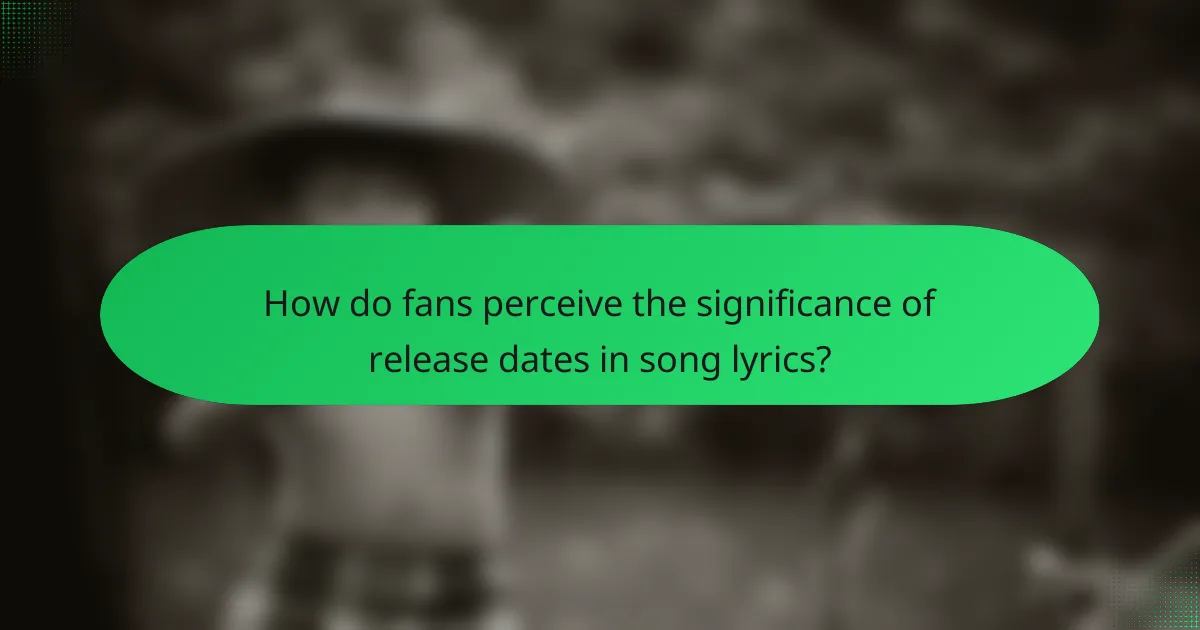
How do fans perceive the significance of release dates in song lyrics?
Fans perceive release dates in song lyrics as crucial markers of context and emotional resonance. They often associate specific songs with personal memories tied to the time of release. This connection can enhance the song’s meaning and impact. Fans frequently discuss how the timing of a release can reflect cultural or social events. For example, a song released during a significant historical moment may evoke stronger feelings. Additionally, fans may analyze lyrics for references to release dates, viewing them as intentional storytelling devices. This analysis can reveal deeper insights into the artist’s intentions and the song’s themes. Overall, release dates are seen as integral to understanding the narrative and emotional landscape of a song.
What emotional connections do fans form related to song release dates?
Fans often form deep emotional connections to song release dates. These dates can mark significant life events, such as graduations or breakups. Fans may associate a song with memories tied to a specific time or experience. The anticipation leading up to a release can create excitement and community among listeners. Additionally, the timing of a release can resonate with current events or personal struggles. This connection can enhance the song’s impact and meaning. Research shows that music is often linked to emotional memories, reinforcing these connections. Fans might celebrate anniversaries of their favorite songs, further solidifying their emotional ties.
How do fans celebrate or commemorate specific release dates?
Fans celebrate specific release dates by organizing events and activities that honor the occasion. These celebrations often include listening parties where fans gather to play the music released on that date. Social media is frequently used to share memories and experiences related to the release. Fans may also create themed merchandise or artwork to commemorate the date. Online forums and fan clubs often host discussions and retrospectives about the significance of the release. Some fans participate in countdowns leading up to the anniversary, building anticipation. Special playlists featuring songs from that release date are commonly shared among fans. Overall, these activities foster a sense of community and shared appreciation for the music.
What role do social media and fan communities play in this perception?
Social media and fan communities significantly influence the perception of release dates in song lyrics. They create platforms for discussion and analysis of song meanings. Fans share interpretations that highlight the importance of release dates. This collective engagement shapes how listeners understand the context of lyrics. Social media allows rapid dissemination of information related to song releases. Fan communities often celebrate or critique these dates, affecting public sentiment. Studies show that online discussions can amplify the significance of particular lyrics. For example, a song released on a historical date may garner increased attention due to fan commentary.
How can release dates enhance the storytelling aspect of songs?
Release dates can enhance the storytelling aspect of songs by providing context and emotional resonance. The timing of a song’s release can align with significant cultural or personal events. For example, songs released during times of social upheaval often reflect the sentiments of that period. This connection can deepen the listener’s engagement with the narrative.
Additionally, release dates can create anticipation and excitement, influencing how stories are perceived. When a song is released on a notable date, it can become part of a larger narrative. For instance, a song released on a national holiday may evoke themes of unity or celebration.
Moreover, the chronological placement of a song within an artist’s discography can shape its story. An album’s release date can signal a shift in an artist’s life or career, adding layers to the song’s meaning. Historical context surrounding the release can further enrich the storytelling.
In summary, the release date acts as a vital anchor for the song’s narrative, enhancing its emotional and contextual depth.
What examples exist where release dates add depth to the narrative?
Release dates can significantly enhance the narrative of songs. For instance, “American Idiot” by Green Day, released in 2004, reflects the socio-political climate during the Iraq War. The timing of its release added urgency to its anti-establishment message. Similarly, “The Message” by Grandmaster Flash and the Furious Five, released in 1982, captures the struggles of urban life in the early 1980s. The date of release contextualizes the lyrics within the socio-economic challenges of that era. Another example is Taylor Swift’s “The Man,” released in 2020, which comments on gender inequality. The release date coincided with a growing global conversation about women’s rights, enhancing its relevance and impact. These examples illustrate how release dates can deepen the listener’s understanding of a song’s themes.
How do artists use release dates to create anticipation or surprise?
Artists strategically use release dates to create anticipation or surprise for their audiences. They often announce release dates well in advance to build excitement. This tactic allows fans to engage in speculation and discussion leading up to the release. For example, artists may tease their upcoming work through social media or interviews before the official announcement.
Additionally, surprise releases, where artists drop music unexpectedly, can generate buzz and immediate engagement. This approach leverages the element of surprise, capturing attention quickly. Historical instances, such as Beyoncé’s self-titled album released without prior notice in 2013, illustrate the effectiveness of this strategy.
By controlling the timing of releases, artists can maximize media coverage and fan interaction. Release dates play a crucial role in shaping the narrative around a project, enhancing its overall impact.
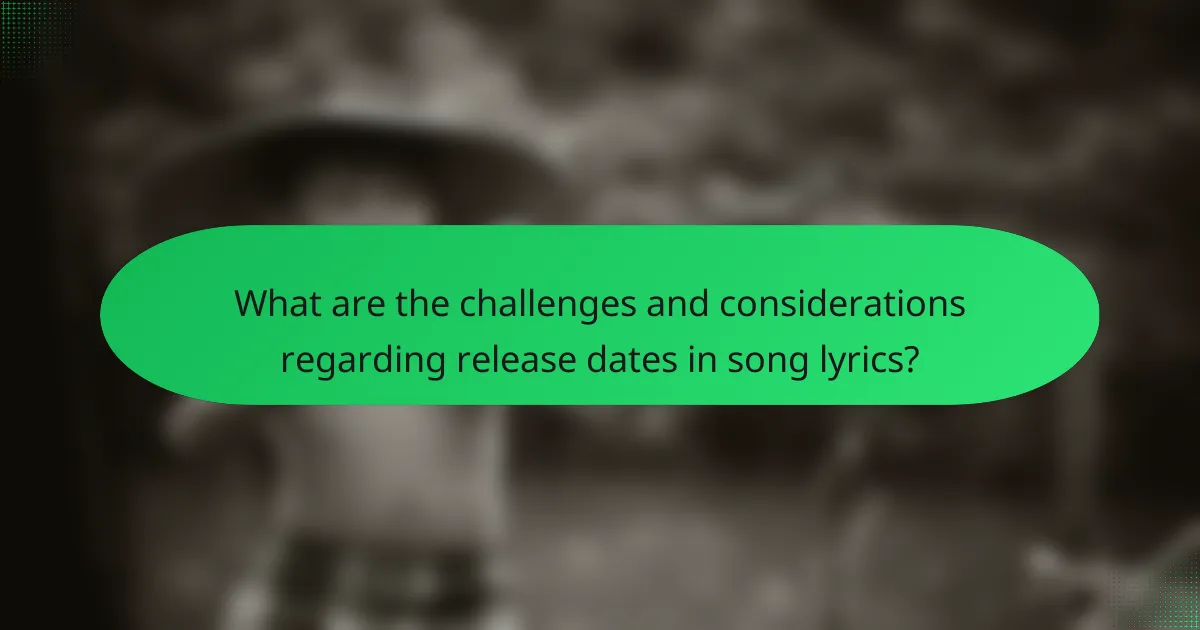
What are the challenges and considerations regarding release dates in song lyrics?
The challenges regarding release dates in song lyrics include timing relevance, market competition, and audience engagement. Timing relevance ensures the song resonates with current events or trends. Releasing a song too early or late can diminish its impact. Market competition involves other artists releasing similar music around the same time. This can overshadow a new release, affecting its success. Audience engagement is critical; if a release date conflicts with major events, listeners may overlook the song. Additionally, promotional strategies must align with release dates to maximize visibility. These considerations highlight the strategic planning required for successful song releases.
How do external factors affect the choice of a release date?
External factors significantly influence the choice of a release date. Market trends dictate optimal timing for audience engagement. Competition from other releases can impact visibility and sales. Seasonal events, such as holidays, may enhance promotional opportunities. Industry events, like award shows, can also affect scheduling. Additionally, cultural moments can create relevance for a release. For instance, a song addressing current social issues may be timed for maximum impact. Historical examples show that strategic release dates can lead to higher chart performance and sales.
What impact do industry trends have on release date strategies?
Industry trends significantly influence release date strategies. Trends dictate consumer preferences and market demand. For instance, artists may choose to release music during peak seasons like summer or holiday periods. Data shows that summer releases often see higher streaming numbers. Additionally, aligning with industry events, such as award shows, can enhance visibility. For example, releasing an album before the Grammy Awards can capitalize on heightened public interest. Thus, release date strategies are often tailored to align with prevailing industry trends to maximize impact.
How can unexpected events alter the perception of a song’s release?
Unexpected events can significantly alter the perception of a song’s release. These events can include natural disasters, political upheavals, or social movements. When such events occur, they can overshadow the song’s intended message or context. For example, a song released during a crisis may be interpreted as a reflection of that situation. This can lead to a heightened emotional response from listeners. Additionally, the timing of the release may affect its reception and popularity. A song that resonates with current events may gain unexpected traction. Historical examples include songs that became anthems during protests or periods of social change. Thus, unexpected events can reshape listener interpretations and cultural significance.
What best practices should artists consider for selecting release dates?
Artists should consider audience engagement and market trends when selecting release dates. Timing can influence the initial impact of a release. For instance, launching music during holidays or major events can increase visibility. Research indicates that releases on Fridays align with industry standards, maximizing streaming potential. Additionally, artists should avoid competing releases from major artists to ensure better chart performance. Analyzing social media trends can help identify optimal dates for audience reach. Overall, strategic planning around release dates can significantly enhance an artist’s success.
How can artists align release dates with their target audience’s preferences?
Artists can align release dates with their target audience’s preferences by analyzing audience behavior and trends. Understanding when their audience is most engaged is crucial. For instance, data shows that music consumption peaks during weekends and holidays. Artists can utilize social media analytics to track engagement patterns. Surveys can also provide insights into preferred release times. Collaborating with industry platforms can enhance visibility during optimal periods. Historical data indicates that artists releasing music during major events often experience increased attention. By strategically timing releases, artists can maximize impact and reach.
What tools and resources can assist in planning effective release dates?
Project management software like Trello and Asana can assist in planning effective release dates. These tools allow teams to create timelines and assign tasks. Calendar applications such as Google Calendar help in scheduling and reminders. They provide visual aids for deadlines and milestones. Social media analytics tools like Hootsuite can analyze optimal posting times. This ensures maximum audience engagement during releases. Additionally, industry reports from sources like Nielsen Music offer insights into market trends. These insights can inform strategic timing for releases.
The main entity of this article is the significance of release dates in song lyrics. The article explores how release dates provide context and relevance to song themes, influence interpretation through cultural and historical contexts, and impact marketing strategies for artists. It discusses the emotional connections fans form with songs based on their release dates, the challenges artists face in timing their releases, and best practices for selecting optimal dates. Additionally, it highlights how external factors and industry trends shape the perception and success of songs upon release.
